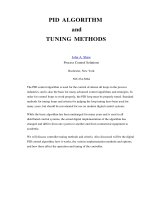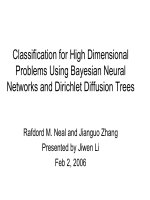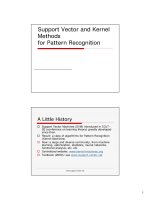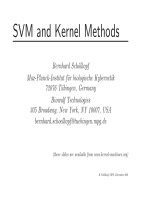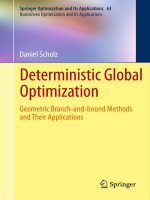bayesian and ensemble methods
Bạn đang xem bản rút gọn của tài liệu. Xem và tải ngay bản đầy đủ của tài liệu tại đây (195.17 KB, 30 trang )
Classification for High Dimensional
Problems Using Bayesian Neural
Networks and Dirichlet Diffusion Trees
Rafdord M. Neal and Jianguo Zhang
Presented by Jiwen Li
Feb 2, 2006
Outline
• Bayesian view of feature selection
• The approach used in the paper
• Univariate tests and PCA
• Bayesian neural networks
• Dirichlet diffusion trees
• NIPS 2003 Experiment Result
• Conclusion
Feature selection, why?
• Improve learning accuracy.
Too many features cause overfitting for maximum likelihood
approaches, but may not for Bayesian methods.
• Reduce the computational complexity.
It is especially a problem for Bayesian methods. But Dimensionality
can be reduced by other means such as PCA.
• Reduce the cost of measuring features in the future.
To make an optimal tradeoff by balancing the costs of feature
measurements and the prediction errors.
The Bayesian Approaches
• Fit the Bayesian model, include your beliefs into the prior by
Note: the model could be complex, and uses all the feature.
• Make predictions using the Bayesian model on the test cases by
Predictions are found by integrating over the parameter space of the model.
• Find the best subset of features based on the posterior distribution of
the mode parameters, and the cost of features used.
Note: Knowing the cost of measuring the feature is essential for making the right
trade-off.
()( | ,)
(| , )
()( | ,)
train train
train train
train train
PPY X
PXY
P
PY X d
θ
θ
θ
θ
θθ
=
∫
(| , ,) (| ,)(| ,)
new new train train new new train train
PYXXY PYX PXYd
θ
θθ
=
∫
Using feature construction instead of
feature selection (1/3)
• Use a learning method that is invariant to rotations in the
input space and which ignores inputs that are always
zero.
• Rotate the training cases so that only n inputs are non-
zero for the training cases, then drop all but one of the
zero inputs.
• Rotate test cases accordingly, setting one input to the
distance from the space of training cases.
Using feature construction instead of feature
selection (2/3)
Use a learning method that is invariant to rotations in the input space and which
ignores inputs that are always zero.
Example: The Bayesian logistic regression model with spherically symmetric prior.
(1)
while β has a multivariate Gaussian prior with zero mean
and diagonal covariance.
Given any orthogonal matrix R, doing linear transform
since , has no effect on probabilities in (1).
1
1
( 1| ) 1 exp( ( ))
n
iii jij
j
PY X x x
αβ
−
=
⎡
⎤
===+−+
⎢
⎥
⎣
⎦
∑
''1
,
ii
XRX R
β
β
−
==
''TT
ii
X
X
ββ
=
1
R
β
−
Using feature construction instead of feature
selection (3/3)
Rotate the training cases so that only n inputs are non-zero for the training
cases, then drop all but one of the zero inputs.
Example: The Bayesian logistic regression model with spherically symmetric prior.
There always exist an orthogonal transformation R, for which all but m of the
components of the transformed features are zero in all m training cases.
PCA is an approximate approaches to doing this transformation. It projects
onto the m principal components found from the training cases, and projects the
portion of normal to the space of these principle components onto some set
of (n – m) additional orthogonal directions. For the training cases, the projections
in these (n - m) other directions will all approximately be zero, so that will be
approximately zero for j > m. Clearly, one then need only compute the first m
terms of the sum in (1)
i
RX
i
X
i
X
'
ij
X
The approach used in the paper
1. Reduce the number of features used for classification to no more than a
few hundred, either by selecting a subset of features using simple uni-
variate significance tests, or by performing a global dimensionality reduction
using PCA on all training, validation and test set.
2. Apply a neural network based on Bayesian learning as a classification
method, using an ARD prior that allows the model to determine which of
these features are more relevant.
3. If a smaller number of features is desired, use the relevance hyper-
parameters from the Bayesian neural network to pick a smaller subset.
4. Apply Dirichlet diffusion trees (an Bayesian hierarchical clustering method)
as classification methods, using an ARD prior that allows the model to
determine which of these features are most relevant.
Feature selection using univariate tests
An initial feature subset was found by simple
univariate significance tests.
Assumption: Relevant variables will be at least somewhat
relevant to the target on their own.
Three significance tests were used:
• Pearson Correlation
• Spearman Correlation
• A runs test
A p-value is calculated by permutation test.
Spearman correlation
• Definition: A linear correlation to cases where X and Y are measured
on a merely ordinal scale.
•Formulary:
where m is the number of data, and
• Advantage for feature selection: Invariant to any monotonic
transformation of the original features, and hence can detect any
monotonic relationship with the class.
• Preprocessing: Transform the feature value to rank.
2
2
6
1
(1)
s
D
r
mm
=−
−
∑
ii
D
xy
=
−
Runs test
• Purpose: The runs test is used to decide if a data set is from a random
process.
• Definition: Run R is length of the number of increasing, or decreasing,
values.
• Step.
1. computer the mean of the sample.
2. Going through the sample sequence, replace any observation with +, or –
depending on whether it is above or below the mean.
3. Computer R.
4. Construct hypothesis test on R.
• Advantage: could be used to detect non-monotonic relation.
• Detail see: Gibbon, J. D. Nonparametric Statistical Inference, Chapter 3.
Permutation Test
• Purpose: calculate the p-value for each feature.
• Principle: If there is no real association, the class labels might as
well be matched up with the features in a completely different way.
•Formulary:
Where the sums are over all m! possible permutations of
, with denoting the class labels as permuted by .
11
2min( ( ), ( ))
!!
xy xy xy xy
pIrrIrr
mm
ππ
ππ
=≥≤
∑∑
12
,,
m
yy y
y
π
π
Dimensionality reduction with PCA
Benefits:
1. PCA is unsupervised approach, which could use all training, validation and test
example.
2. Bayesian model with the spherically symmetric prior is invariable to PCA
3. PCA is feasible even when n is huge, if m is not too large – time required is
of order min(mn², nm²).
Practice:
Power transformation is chosen for each feature to increase correlation with the
class. Whether to use these transformations, and the other choices, were made
manually based on validation set results.
Some issues proposed in the paper:
1. Should features be transformed before PCA? Eg, take square roots.
2. Should features be centered? Zero may be informative.
3. Should features be scaled to have the same variance? Original scale may carry
information about relevance.
4. Should principle components be standardized before use? May be not.
Tow Layers Neural Networks (1/2)
• Multilayer perceptron networks, with two hidden layers with tanh
activation function.
[
]
1
1
1
1
(1
|
) 1 exp( ( ))
() ()
() tanh( ())
() tanh( )
iii i
H
illi
l
G
li l klki
k
n
ki k jkij
j
PY X x f x
fx c whx
hx b vg x
gx a ux
−
=
=
=
===+−
=+
=+
=+
∑
∑
∑
Two Layer Neural Networks (2/2)
.
.
.
.
.
.
.
.
.
i
j
X
j
k
u
kl
v
l
w
()
ki
gx
(
)
li
hx
()
i
fx
N input
features
G hidden
units
H hidden
units
Conventional neural network learning
• Learning can be viewed as maximum likelihood
estimation for the network parameters.
• Value of weights is computed by maximizing
Where are training case i.
• Make predictions for a test case x using the conditional distribution
• Overfitting happen when the number of network parameters is large
than the number of training cases.
ϖ
1
(|,)
m
ii
i
Py x
ω
=
∏
(,)
ii
xy
(|,)Pyx
ϖ
Bayesian Neural Network Learning
• Bayesian predictions are found by integration rather than
maximization. For a test case x, y is predicted using
• The posterior distribution used above is
• We need to define a prior distribution .
11
11
( | ,( , ), ( , ))
( ) ( | , ) ( | ( , ), ,( , ))
mm
mm
Pyx x y x y
dPyx P xy xy
ωωω
=×
∫
11
1
(
|
( , ), ,( , )) ( ) (
|
,)
m
mm i i
i
Pxy xy P Pyx
ω
ωω
=
∝
∏
ARD Prior
• What for?
By using a hierarchical prior, we can automatically determine how relevant
each input is to predicting the class.
•How?
Each feature is associated with a hyper-parameter that expresses how
relevant that feature is. Conditional on these hyper-parameters, the input
weight have a multivariate Gaussian distribution with zero mean and
diagonal covariance matrix, with the variance as hyper-parameter, which is
itself given a higher-level prior.
•Result.
If an input feature x is irrelevant, its relevance hyper-parameter β will tend to
be small, forcing the relevant weight from that input to be near zero.
Dirichlet Diffusion Trees Procedure(1/2)
A Dirichlet diffusion tree model defines a procedure for generating data
sets one point at a time in an exchangeable way.
Procedure
• The first point is generated by a simple Gaussian diffusion process
from time 0 to 1
• The second point follows the path of the first one initially.
• The second point diverges from the path at a random time t.
• After the divergence, the second point follows a Gaussian diffusion
process independent of the first one.
Dirichlet Diffusion Trees Procedure(2/2)
Procedure (continue)
• The nth point follows the path of those before it initially.
• The nth point diverges at a random time t
• At a branch, the nth point selects an old path with probability
proportional to the numbers of points that went each way previously
• After the divergence, it follows a Gaussian diffusion process
independently.
Divergence Function
• If a point following a path of n points did not
diverge at time t, the probability of divergence
during dt is a(t)dt/n.
• With more points passing the way, the
probability of divergence for a new point is
smaller.
Selection of divergence function
• Select a(t) such that
• To keep the distribution continuous.
• Two possibilities
•Or
1
0
()atdt
=
∞
∫
()
1
c
at
t
=
−
()
2
()
1
c
at b
t
=+
−
• Structure
The structure of the tree
The divergence times for non-terminal nodes
• Hyper-parameter
Parameters of the divergence function – for example, c
in a(t) = c/(1-t).
Diffusion standard deviations for each variable.
Noise standard deviations for each variable.
Bayesian learning of Dirichlet diffusion tree
• Likelihood
The probability of obtaining a given tree and data set can be written
as a product of two factor.
-The tree factor is the probability of obtaining the given tree structure
and divergence times.
-The data factor is the probability of obtaining the given locations for
divergence points and final data points, given the tree structure and
divergence times.
•Prior
Using ARD again.
-By using a hierarchical prior, we can automatically determine how
relevant each input is to predicting the class.
